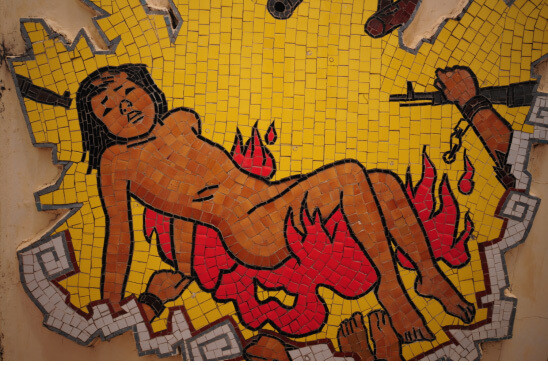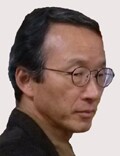hankyoreh
Links to other country sites 다른 나라 사이트 링크
[Column] A scar across humanity’s conscience

President Moon Jae-in apologized during a Mar. 23 visit to Vietnam for South Korean troops’ participation in the Vietnam War and massacres of civilians. His was the third such presidential apology, after previous ones by Kim Dae-jung and Roh Moo-hyun. While President Moon had reportedly intended to give a clear and public apology, the Vietnamese government substantially moderated its content out of concerns that it would underscore internal issues concerning fratricidal warfare.
We must examine the roots of the Vietnam War to understand why that conflict, out of all the many brutal conflicts in modern history, has been named alongside the Spanish Civil War as a “scar across humanity’s conscience,” and why the people of the US, who had viewed it as a solemn duty to raise memorial structures once their wars had ended, resisted building a memorial for the fallen soldiers in Vietnam for ten years.
While most of the leaders in North Vietnam and the Viet Cong (National Liberation Front) were independence activists who had resisted French colonial rule, most of the South Vietnamese leaders were colonial administration officials and military men. John Paul Vann, who served as a senior advisor for the US’s “pacification plan” for Vietnam, explained that the reason the South Vietnamese government failed to establish a popular political base was because it had carried on the system of the French colonial government.
Most Vietnamese people supported the Viet Cong and North Vietnam’s approach not because they were communists, but because they longed for their country’s liberation. As a result, the US and South Vietnam had to fight against a majority of Vietnamese people rather than simply North Vietnam and the Viet Cong. Even unarmed civilians were seen as “the enemy.” This is the reason for the war’s unavoidable brutality.
In the summer of 1969, the US Air Force carried out heavy bombing on Kien Hoa in the Mekong River Delta region. Afterwards, 50 armed helicopters with the 9th Infantry Divisions went from village to village. Their targets for fire were anyone they saw – what Asahi Shimbun foreign correspondent Katsuichi Honda described as “Asian-hunting.” According to official records, just 748 weapons were seized for 1,899 “enemies” slain.
Diane and Michael Jones, two Vietnamese-speaking Quakers from the US, conducted an intensive five-year survey in regions where South Korean forces had conducted operations. They found 12 instances of massacres at a similar scale to the My Lai incident, in which US Marines killed nearly 100 civilians with their personal weapons. Many more massacres took place at smaller scales, with women, children, and senior citizens representing most of the victims.
In an article titled “Vietnam killings left to allies,” New York Times reporter Robert Smith wrote that South Korean forces were slaying one-tenth of civilians in the villages they occupied, with no questions asked. A South Korean officer told the reporter that it was a tactical approach of “drawing water and catching fish” - the water representing civilians, the fish communists.
The US Cold War ideology represented by McCarthyism and the Vietnam War was an ideological basis for pursuit of the Pax Americana. The first venue for its application was the Korean Peninsula. Amid the hegemonistic battle between the US and Soviet Union, South and North Korea experienced the unprecedented tragedy of the Korean War, armed with ideologies of hatred – anti-communism and anti-Americanism. The South Korean forces’ massacres of Vietnamese civilians were a manifestation of this hatred and anti-communist ideology.
Tracing this hatred back further, we find the tragedy of the events surrounding the April 3 Jeju Uprising in 1948. According to records, the military and police’s punitive expedition only found around 500 armed Jeju residents, but at least 30,000 people were slain. A US military report credited the “civilian massacre plan” as the reason for the campaign’s success. To confront the Vietnam War is to confront tragedies on the Korean Peninsula as a setting for Cold War clashes.
On Mar. 7, 2014, the Korean Council for the Women Drafted for Military Sexual Slavery by Japan (Jeongdaehyeop) held a press conference for International Women’s Day on Mar. 8 and the second anniversary of the Butterfly Fund. “It’s time for the South Korean government to find the truth about the civilian massacres and crimes of sexual assault committed by South Korean troops during the Vietnam War, to clearly acknowledge them as war crimes and apologies to the victims and their surviving family members,” the group said.
“Having held the Japanese government responsible for war crimes [with the drafting of ‘comfort women’ as sexual slaves to the military], it is natural for Jeongdaehyeop to repent for and speak out against our military’s misdeeds committed in Vietnam,” it added.

On July 25, 2017, the Foundation for Justice and Memory to Resolve the Japanese Military Sexual Slavery System Issue selected Korea-Japan Peace Foundation board member Ku Su-jeong – the first person to share the story of the civilian massacres with the South Korean public – as the winner of the first Gil Won-ok Women’s Peace Award. The awards were established with a seed fund of 1 million won (US$940) from the prize money received by Gil, a comfort woman survivor, when she was selected as the first Ewha Christian Women’s Peace Prize honoree.
To confront the Vietnam War is to confront humanity’s single worst crime: war itself.
By Jung Chan, novelist
Please direct questions or comments to [english@hani.co.kr]

Editorial・opinion
![[Column] Park Geun-hye déjà vu in Yoon Suk-yeol [Column] Park Geun-hye déjà vu in Yoon Suk-yeol](https://flexible.img.hani.co.kr/flexible/normal/500/300/imgdb/original/2024/0424/651713945113788.jpg) [Column] Park Geun-hye déjà vu in Yoon Suk-yeol
[Column] Park Geun-hye déjà vu in Yoon Suk-yeol![[Editorial] New weight of N. Korea’s nuclear threats makes dialogue all the more urgent [Editorial] New weight of N. Korea’s nuclear threats makes dialogue all the more urgent](https://flexible.img.hani.co.kr/flexible/normal/500/300/imgdb/original/2024/0424/7317139454662664.jpg) [Editorial] New weight of N. Korea’s nuclear threats makes dialogue all the more urgent
[Editorial] New weight of N. Korea’s nuclear threats makes dialogue all the more urgent- [Guest essay] The real reason Korea’s new right wants to dub Rhee a founding father
- [Column] ‘Choson’: Is it time we start referring to N. Korea in its own terms?
- [Editorial] Japan’s rewriting of history with Korea has gone too far
- [Column] The president’s questionable capacity for dialogue
- [Column] Are chaebol firms just pizza pies for families to divvy up as they please?
- [Column] Has Korea, too, crossed the Rubicon on China?
- [Correspondent’s column] In Japan’s alliance with US, echoes of its past alliances with UK
- [Editorial] Does Yoon think the Korean public is wrong?
Most viewed articles
- 1‘We must say no’: Seoul defense chief on Korean, USFK involvement in hypothetical Taiwan crisis
- 2N. Korean delegation’s trip to Iran shows how Pyongyang is leveraging ties with Moscow
- 346% of cases of violence against women in Korea perpetrated by intimate partner, study finds
- 4[Column] Park Geun-hye déjà vu in Yoon Suk-yeol
- 5‘Weddingflation’ breaks the bank for Korean couples-to-be
- 6Will NewJeans end up collateral damage in internal feud at K-pop juggernaut Hybe?
- 7Amnesty notes ‘erosion’ of freedom of expression in Korea in annual human rights report
- 8[Interview] Dear Korean men, It’s OK to admit you’re not always strong
- 9Korean government’s compromise plan for medical reform swiftly rejected by doctors
- 10[Editorial] Japan’s rewriting of history with Korea has gone too far